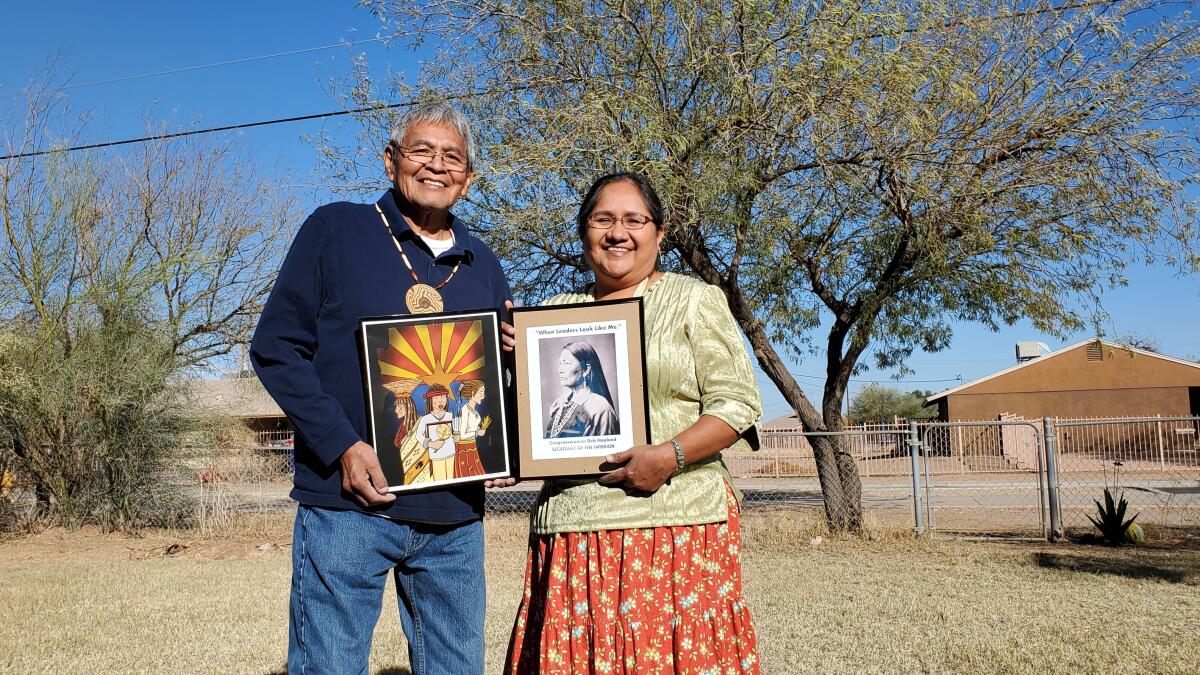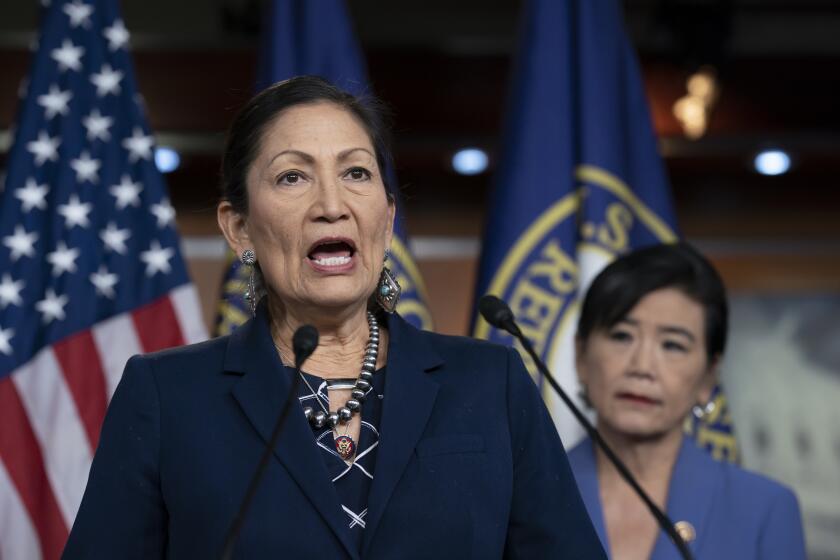Indian Country gripped by Debra Haaland’s Interior secretary hearings

- Share via
FLAGSTAFF, Ariz. — For Native Americans, Debra Haaland is more than an elected official on track to become the first Indigenous secretary of the Interior Department. She is a sister, an auntie and a fierce Pueblo woman whose political stances have been molded by her upbringing.
News of her historic nomination electrified Indian Country. Tribal leaders and organizations for weeks have urged people to write and call U.S. senators who will decide if she’ll lead the agency that has broad oversight over Native American affairs and energy development.
Haaland’s confirmation hearing this week was closely watched in tribal communities, with some virtual parties drawing hundreds of people. The hearing started Tuesday and continued Wednesday.
Deb Haaland would be first Indigenous Cabinet member, running the agency that oversees federal land and American Indian affairs.
To mark the event, supporters projected a picture of the New Mexico congresswoman on the side of the Interior Department building with text that read “Our ancestors’ dreams come true.” A mobile billboard with Haaland’s image also made its way around Washington, D.C.
Many Native Americans see Haaland as a reflection of themselves, someone who will elevate their voices and protect the environment and tribes’ rights. Here are stories of her impact:
________
Aleta ‘Tweety’ Suazo, 66, Laguna and Acoma Pueblos in New Mexico
Suazo first met Haaland when they were campaigning for Barack Obama, walking door to door in New Mexico’s pueblos.
When Haaland was chosen to represent New Mexico as one of the first two Native American women ever elected to Congress, she asked Suazo and the state’s Native American Democratic Caucus to make treats for a reception.
They prepared hundreds of pueblo pies, or pastelitos, and cookies, froze them and took them to Washington. Wearing traditional black dresses, they handed out the goodies with thank-you notes from Haaland.
Suazo said she admires Haaland because she is eloquent and smart — “no beating around the bush” — and she is a Laguna Pueblo member who has returned there to dance as a form of prayer.
When she heard Haaland was nominated as Interior secretary shortly after winning a second term in Congress, Suazo wasn’t overjoyed.
“Oh, my gosh, she is going to go there, and who is going to represent us?” said Suazo, who lives in Rio Rancho, N.M. “There goes our one and only Indian representative.”
She wanted to be assured that Haaland would be replaced by someone just as dynamic, who would work hard to protect the environment, address an epidemic of missing and slain Indigenous women and expand broadband internet access, she said.
“I was happy, but I was afraid. I didn’t want to lose her,” Suazo said.
But she sees the importance, she said, in having a Native American oversee an agency that touches nearly every aspect of Native American life.
Suazo sent a message to Haaland ahead of the hearing to say “be a strong woman,” or “gumeh.” She went back and forth watching it on television and in a virtual party.
“It kind of reminds me of people having prayer groups — that kind of collective sending [of] good thoughts and prayers and support — and to have that many people doing it at one time was just so great,” Suazo said.
____
Brandi Liberty, 42, Iowa Tribe of Kansas and Nebraska
When Liberty saw a picture of Haaland in a traditional ribbon skirt and moccasins for Joe Biden’s inauguration, she cried.
She thought about her grandmother Ethil Simmonds Liberty, who didn’t become a U.S. citizen until she was 9 despite being born on her tribe’s reservation, which straddles Kansas and Nebraska. Her grandmother was a powerful advocate for her people, petitioning to turn a pigpen into a playground, writing letters to U.S. presidents and leading efforts to get a road to the reservation paved, she said.
Brandi Liberty thought about her own daughter, who she hopes will carry on her legacy in working with tribes and embracing their heritage.
She thought about her time earning a master’s degree and seeing single mothers bringing their children to class, each understanding it wasn’t a burden but a necessity. She later became a single mother like Haaland, who often speaks about her experience working through college and amassing debt.
Liberty also thought about how Haaland could move other tribes in the right direction and connect them to Washington. Essentially, Liberty’s grandmother on a larger scale.
“This is no different than when Obama became the first Black president and what that signified,” said Liberty, who lives in New Orleans. “This is a historical mark for Indian Country as a whole.”
Liberty caught most of Tuesday’s hearing while updating her parents and others through texts and social posts. She found herself in tears again as Haaland made her opening statement and touched on personal struggles.
“I could relate to so much of it,” Liberty said.
____
Zachariah Rides At The Door, 21, Blackfeet Tribe of Montana
Rides At The Door is studying environmental sciences and sustainability as well as fire science as a third-year student at the University of Montana in Missoula.
He brings a perspective to his studies that Haaland has touted as unique from Indian Country — that everything is alive and should be treated with respect and that people should be stewards of the land, rather than have dominion over it.
In high school, he learned about the mining industry and how it has affected sites that are part of the Blackfeet creation story. He learned about the American Indian Movement’s role in fighting for equality and recognition of tribal sovereignty. He also recently learned the United States had a Native American vice president from 1929 to 1933, Charles Curtis.
Rides At The Door isn’t sure what he wants to do when he graduates. But he knows he wants to learn the Blackfeet language, and maybe become a firefighter or work on projects to route buffalo to his reservation.
He was working Tuesday but planned to catch up on the hearing through social media. Already, he was seeing memes and other posts that praised Haaland.
Seeing her political rise is inspiring, he said.
“It’s a great way for younger Natives to say, ‘All right, our foot is in the door. There’s a chance we could get higher positions.’”
___
Debbie Nez-Manuel, 49, Navajo Nation in Arizona, New Mexico and Utah
During her recent campaign for an Arizona legislative seat, Nez-Manuel sought an endorsement from Haaland. She was looking for someone whose values aligned with hers: grounded in beliefs, connected to the land, a consistent and strong leader unchanged by politics.
After layers of vetting, she got the endorsement and planned to announce it at a get-out-the-vote rally featuring Haaland at the Gila River Indian Community in Arizona. It also was a chance for the two women to take a picture together.
Then the event was canceled because of the pandemic. Nez-Manuel was devastated.
Days before she was supposed to meet Haaland, Nez-Manuel was sitting at home when her phone rang. She didn’t recognize the number.
“Hey Debbie, this is Deb,” the voice on the phone said.
“Who?” Nez-Manuel asked.
The caller replied: “Deb Haaland. Good morning. I’m calling from New Mexico. I’m sitting in my kitchen.”
Nez-Manuel’s heart raced, and she struggled to voice all the thoughts she had so carefully scripted for that meeting. Haaland, she said, was patient and shared stories about life on and off a reservation — something that resonated with Nez-Manuel.
“It’s like talking to an auntie,” she said. “She’s very matter-of-fact.”
Nez-Manuel joked about flying to Washington for Haaland’s confirmation hearing to get that elusive picture.
Instead, she and her husband, Royce, connected to a virtual watch party from their home on the Salt River-Pima Maricopa Community northeast of Phoenix. Nez-Manuel said Haaland showed she was willing to learn from others, aptly answering questions and pledging to make decisions based on science.
“She is about protecting what’s there, what’s good for humanity, not for pocketbooks,” Nez-Manuel said. “That’s something that stood out very clearly.”
More to Read
Sign up for Essential California
The most important California stories and recommendations in your inbox every morning.
You may occasionally receive promotional content from the Los Angeles Times.











